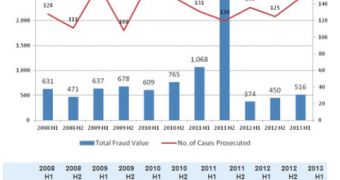The value of fraud in the UK in the first half of 2013 increased to £516 million ($773 million / €600 million). Compared to the same period of 2012, this represents a 38% increase, according to KPMG’s fraud barometer.
Of this amount, £61 million ($91 million / €71 million) has been attributed to supply chain fraud, which causes not only financial losses, but also human harm.
“While the back end of last year saw a resurgence of traditional con artistry, this year has seen fraud cases turn a darker corner with professional criminals acting across borders for the purpose of defrauding largely governments and financial institutions,” Hitesh Patel, UK forensic partner at KPMG, commented.
“What has been really marked is the increase in the corruption of supply chains by fraudsters. In one particularly shocking case, a company sold fake bomb detectors to Iraqi authorities, at a financial cost of £55m, but the real damage was human injury and suffering,” he added.
“The risk to safety and therefore life through supply chain fraud can have serious operational and reputational consequences which often get overlooked as a result of financial impact being a primary focus.”
The government and financial institutions have been affected the most. These two sectors have suffered losses totaling £405 million ($607 million / €471 million).
“What is clear from this year’s report is that fraud is on the up and remains a huge cost to government and the private sector. It is a welcome development to see that the Government continues its fight against white collar crime,” Patel noted.
“A very severe punishment regime is being proposed in the sentencing guidelines consultation paper issued recently to tackle the growing scourge of white collar crime and the acknowledgement that the real cost of fraud is more than just financial.”
Interestingly, the report shows that 87% of fraud crimes were committed by men in the first half of this year. In addition, 87% of fraudulent activities were carried out by individuals aged over 35.

 14 DAY TRIAL //
14 DAY TRIAL //